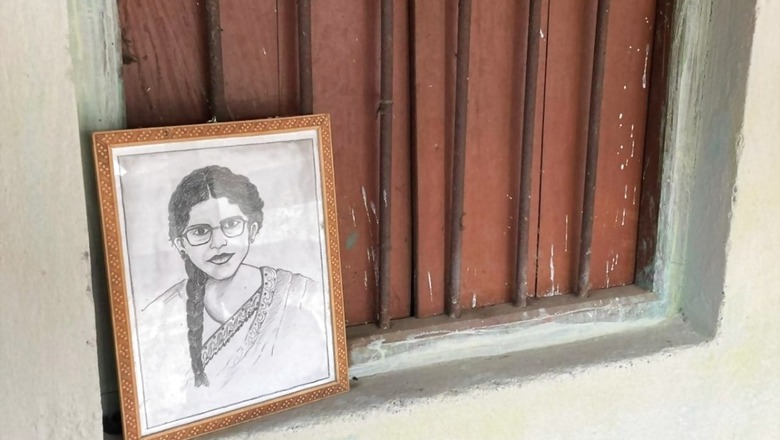
views
“I cannot take this anymore,” Chuni Kotal told her family members days before she died by suicide at a hostel in West Midnapore in August 1992.
Kotal was a Dalit Adivasi who in 1985 earned the distinction of becoming the first woman graduate from the Lodha Shabar tribe. She took a job as a hostel superintendent, but trouble began while she was pursuing a master’s degree at Vidyasgar University.
She was insulted for her “neechu jaat (lower caste)”, subjected to blatant discrimination and faced casteist slurs. Kotal could not take it anymore.
“She was just 27 years old and struggling with her caste identity. It was a tragic incident…She was humiliated during her higher studies because of her caste,” says Mrinal, her nephew.
Mrinal, who has started the Chuni Kotal Charitable Trust (it works to promote education among tribal people), says Kotal was not the only one to face such discrimination in West Bengal, which has been traditionally perceived to be a state having minimum influence of caste on its polity and society.
“There are many from the tribal and lower caste communities who are still facing discrimination…Even politicians are targeting us for their vote bank politics,” Mrinal adds.
Kotal’s death sent shock waves across Bengal, generating heated debates in the state’s socio-political circles dominated by the “bhadralok (gentleman)”. There were protest rallies on streets. But as the dust settled on the issue, the caste debate took a back seat once again.
According to observers, the undercurrent of caste has always been there in Bengal, but that never swept the centre stage of politics in this eastern state. Until recently. Experts and analysts say host of reasons, including the changing socio-cultural landscape, have catapulted the caste debate to the mainstream in this election season.
CASTE OR CLASS?
According to observers, the Left Front, which ruled Bengal from 1977 to 2011, mobilised the backward sections for political purposes, but not in the name of caste. The communists tried empowering the lower castes against the social elite and the wealthy, who they called class enemies.
In a way, this class tension took a toll on Bengal’s development and economy in the long run with many industries moving away from the state, especially due to strikes and protests by labour unions, which were dominated by lower castes.
“Left Front, or to some extent the Congress (which ruled Bengal before the Left), had mobilised castes by ridiculing elites in rural Bengal. They played politics based on…economy and we all know what happened after that…due to labour unions issues and strikes,” says Debi Chatterjee, a researcher in caste politics and a former professor of international relations at the prestigious Jadavpur University in Kolkata.
The Left empowered rural Dalits and tribal people, who outnumbered rural elites, by trying to bring lower caste groups under the common umbrellas of para (locality) clubs and small village committees. They were also given decision-making powers in some matters. Thus, the Left achieved major political gains without segregating people based on their castes.
“For decades, matrimonial pages of vernacular dailies in Bengal have silently spoken about the caste factor in this cultural capital of India. The caste factor was always there in Bengal, but they (the Left) mobilised socially oppressed people cleverly, in a different way…,” Chatterjee said.
According to Chatterjee, the issue is now openly discussed because the lower caste groups, especially the educated new generation, are becoming vocal and assertive about their rights. “It is forcing parties to chalk out strategies to woo them openly.”
Chief minister Mamata Banerjee breached the Left citadel in 2011, heralding a new era in Bengal politics. Her Trinamool Congress (TMC) rode to power with the backing of social groups such as Matuas, Rajbonshis, Kamtapuris, Gorkhas, Santhals, Lodha Shabars, Mundas, Bagdis and Bauris, among others. Her government has delivered caste certificates as part of the flagship Duare Sarkar (government at the doorstep) programme.
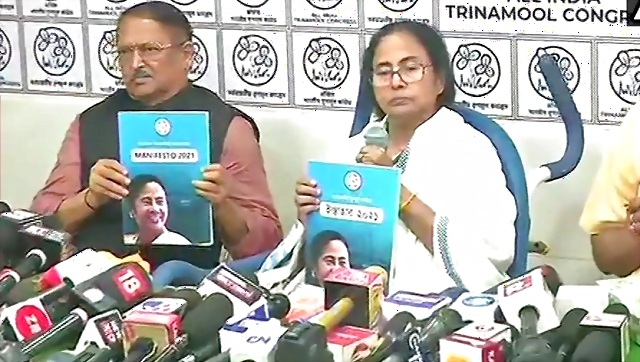
CM Mamata Banerjee releases her manifesto for the upcoming West Bengal elections.
In the 2014 Lok Sabha elections and the 2016 assembly polls, the TMC got the support of the leaders of these groups, including Binapani Devi Thakur, the influential Matua leader who died on March 5, 2019.
THE DEBATE BEGINS
CNN-News18 reached the famed Thakurbari (temple) of the Matuas in Thakurnagar in North 24-Parganas district. The priest was busy arranging items for daily rituals. Swapan Roy, a resident of Bashirhat, was waiting along with his daughter, Tisha, for their turn to get a sacred tulsi mala (garland).
Come this election and Tisha will be a first-time voter. She is a proud Matua, who are Dalit refugees from Bangladesh and account for a large section of namasudras in Bengal. She wants the Centre to immediately implement the Citizenship Amendment Act, or CAA, which fast-tracks citizenship of Hindus, Sikhs, Jains, Buddhists, Christians and Parsis who have arrived in India from Pakistan, Afghanistan and Bangladesh before 2015. Tisha also wants her Bengal to flourish.
“I belong to the Matua community and I am very emotional about it. We want to live with dignity. And therefore we support the Citizenship Amendment Act. Like other communities, we too need our own space in this society,” she says.
In Kolkata, another first-time voter, Anant Gupta, says people are actually discussing the caste factor with the rise of the Bharatiya Janata Party (BJP). “We do discuss caste, but in a limited way. I am Marwari and belong to the Baniya community. But do we discuss caste to discriminate against others? The answer is no,” he says.
But not all share his views. Ask professor Maroona Murmu of Jadavpur University and she will testify to this. Last September, Murmu, a tribal person, expressed concerns on the social media over the University Grants Commission (UGC)’s decision to hold final-year and final-term examinations in the middle of the Covid-19 outbreak.
What followed was a nightmare. She drew a volley of ugly criticism, including that by a Kolkata student who questioned Murmu’s academic credentials, claimed she got the job due to the quota system, and “reminded” her of her Adivasi lineage.
“I never thought that I will face casteist remarks in Bengal. I only said ‘life is long and nothing will happen if examinations were not held for one year because of Covid-19’. Instead of going into the core issue, people started commenting about my caste and quota. I belong to a tribal community and I think I have the right to express my views on current affairs without drawing objectionable comments,” Murmu says.
UNDERCURRENTS TO THE SURFACE
Dr Ashish Thakur, a well-known Matua leader and a physician, says there has been an undercurrent among the people belonging to lower caste communities in Bengal for decades. They wanted to be empowered but were finding it difficult in a society dominated by upper caste elites, he adds.
“In the past, we have seen people from SC (Scheduled Castes), ST (Scheduled Tribes) and OBC (Other Backward Classes) communities hitting the streets, but that failed to draw much attention. In 2010, nearly 300,000 Matuas and refugees backed by other lower caste groups gathered at Esplanade in Kolkata, demanding implementation of the Mandal Commission (recommendations) and their betterment. It was for the first time that the caste factor was openly and prominently felt in Bengal,” says Thakur, a resident of Patuli in South 24-Parganas.
According to him, there have been talks, albeit in a limited way, for a political front for lower castes. “Unfortunately, it never took off because political parties such as the Left, the Congress, the TMC and the BJP never wanted that to happen…it was also due to lack of unity among Dalits and the allegiance of some sections among them to mainstream parties…this is the reason why Bengal doesn’t have political parties based on castes, like Uttar Pradesh and Bihar have.”
He says Bengalis prefer silence on the issue “because if they say they believe in caste, he or she will lose the progressive image in the society”.
Thakur says people have begun discussing caste out of frustration because the Mandal Commission recommendations “were not implemented logically in Bengal”. “Now when the election is there, both the BJP and the TMC are promising to form a commission to include the left-out castes such as Kumvhokars, Mahisyas, Sahas and Telis etc. in the OBC category. People are made to believe in caste by the politicians.”
He adds that there are deep divisions even among the lower castes based on their economic status. “A rich tribal family will not allow a poor man or woman belonging to the same caste to sit at the dining table. This discrimination is also there.”
Gopal Biswas, a retired banker and an activist, agrees with Thakur. “Unlike the Hindi belt, where people take a lot of pride in discussing castes, people in Bengal talk of caste in a sugar-coated manner,” he says.
“Nobody will openly say that they discriminate against people, but at the ground level, they actually discriminate on the basis of a person being a Shudra or a Vaishya…I belong to the Matua community, and we don’t believe in any caste system,” Biswas, a resident Madhyamgram in North 24-Parganas, adds.
THE POLITICS OF CASTE
While CM Banerjee ousted the Left on the back of protests against land acquisition in Singur and Nandigram, she focused on doles for backward sections and what the BJP calls “appeasement” of Muslims after coming to power. The BJP, on the other hand, saw the latter as an opportunity to consolidate the Hindu votes.
In 2014, Dilip Ghosh, then an active Rashtriya Swayamsevak Sangh (RSS) worker, was appointed the state general secretary. A year later, he was promoted as the state party president. Under his leadership, the BJP extensively worked on mobilising Hindu Bengalis irrespective of their caste, even as the ruling party played the “Bangaliana (Bengaliness)” card in order to reach out to all castes and religions.
The BJP strategy worked well. In the 2019 Lok Sabha elections, it secured nearly 57% of the Hindu votes against the 32% secured by the TMC. The BJP won 18 of the state’s 42 Lok Sabha, only four fewer than the TMC’s 22. A large section of the Matuas is believed to have supported the BJP for its commitment to implementing CAA. However, 70% of the Muslim voters in the state opted for the TMC in 2019 Lok Sabha polls.
In the 2016 state polls, Banerjee’s TMC won 211 of the 294 assembly seats. Of them, Muslims played a key role in 98 constituencies with their vote share in these seats ranging from about 20% to about 30%.
THE BATTLE FOR DOMINANCE
Faced with the BJP’s aggression, Banerjee has announced several sops for Hindus in her recent political meetings. A few of the crucial announcements were allowances for Sanatan Brahmin priests, and plans to build a “Maha Tirtha Bhumi (great pilgrimage land)” and a “Maha Punya Bhumi (great sacred land)” in Bengal.
As it came to the fore that a sizeable portion (about 30%) of the Left and Congress supporters (mainly Dalits, SC/ST and OBCs) helped the BJP in 2019, Banerjee began campaigning aggressively in lower caste-dominated areas, announcing the formation of various welfare boards.
She has reached out to the influential Kurmi community in Jangalmahal, which is spread over Purulia, Jhargram, West Midnapore and Bankura districts. The Hindu card does not ring a bell among the Kurmis, who have 38-40% vote share in these four districts. They have been fighting for the official recognition of the “Sarna Dharma (nature worship)” for several years. Kurmi community leaders allege that they are forced to follow Hindu rituals.
In 1913, during the British rule, Kurmis were listed in the ST category. They were dropped from the list on September 6, 1950. Presently, they are in the OBC (B) list and demanding ST status.
Banerjee has also reached out to the Bauris and Bagdis (Barga Kshatriyas), who are believed to have supported the BJP in 2019. With nearly 19% of the state’s vote share, they are under the spotlight with the chief minister announcing several schemes for their welfare, including a university in the name of Gobardhan Dikpati (a Bauri fighter who was hanged by the British during the Chuar rebellion).
She has reached out to the Nashya Sekhs, who account for 13-15% of the voters in North Bengal. Their predecessors were from Koch, Rajbonshi and Poliya communities who came under the rule of Muḥammad Bakhtiyar Khilji during his conquest of North Bengal. They converted to Islam and became the Nashya Sekhs, which means the “fallen”.
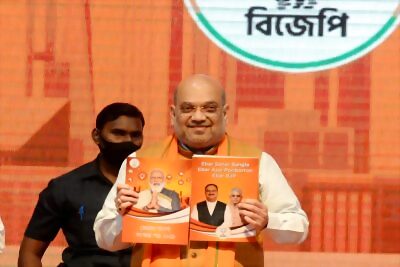
Amit Shah releases the BJP’s ‘Sankalp Patra’ for Bengal elections.
On the other hand, the BJP’s game plan for the 2021 assembly elections is loud and clear: consolidation of the Hindus cutting across castes with a share of the Muslim votes. And it is in this backdrop that the caste debate is taking the centre stage in battle ground Bengal.
Political expert Kapil Thakur reiterates that caste-based politics has always been there in the state, though it was “never highlighted” before. According to him, at present both the BJP and the TMC are playing the caste card, bringing the issue to the centre of discussions.
“The day after Chuni Kotal died, we launched a movement against caste discrimination in Bengal. Then, a commission was set up, but her family members did not get justice. The caste politics is now open in public as the BJP has made it very clear before the people that they are consolidating the Hindus…,” he says.
What waits to be seen is which strategy will win over Bengal’s electorate: Banerjee’s push for a wider Bengali identity (encompassing all, including marginal communities such as Lodhas, Sabars, Santhals, hill tribes, and Muslims)? Or the BJP’s strategy of tagging SCs/STs, OBCs and all such ethnic groups under the Hindu fold for a greater Hindutva spectrum? The answer will be known on May 2, the judgement day.
Read all the Latest News, Breaking News and Coronavirus News here

















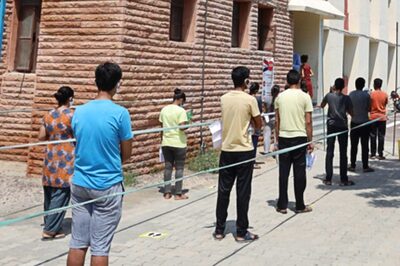

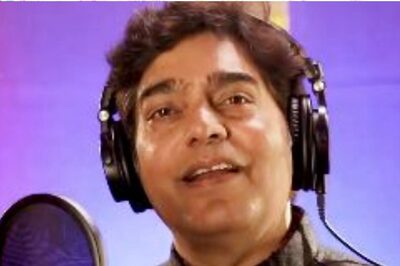
Comments
0 comment